Converting Engines, and the E85 Narrative
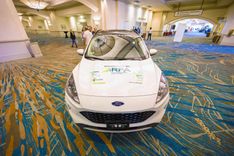
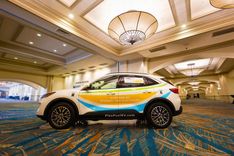
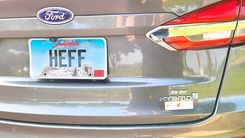
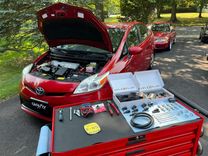
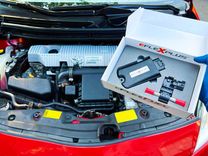
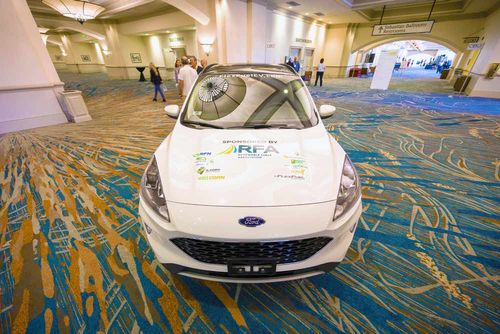
After buying the Ford Escape plug-in hybrid electric vehicle and converting it to run on E85, the Renewable Fuels Association has displayed it across the country. / PHOTO: RENEWABLE FUELS ASSOCIATION
September 13, 2023
BY Luke Geiver
Whether Tuomo Isokivijärvi is meeting with venture capitalists in Palo Alto, California, Finland or anywhere else in the world, he’s usually trying to explain how his company’s E85-based conversion kit technology applies to current and future light-duty passenger vehicles. He doesn’t shy away from explaining the limitations of electric vehicles—why EVs alone won’t be able to fulfill the transportation needs of the world anytime soon, despite what many investors have been repeatedly told. And he relays the comparable affordability of the eFlexFuel technology his company, StepOne Tech Ltd., has commercialized over the past decade. Isokivijärvi is quick to explain that adding an eFlexFuel conversion kit to a compatible vehicle achieves the same lifetime emissions reduction as switching to a battery EV—for less than the price of a new smartphone.
Although there are other technology providers offering similar products to StepOne Tech’s eFlexFuel conversion kit, none have taken the steps to push the idea of such ethanol-based technology forward quite like Isokivijärvi. Should it work and catch on, E85 could be heightened to a different status, Isokivijärvi believes, and ethanol’s highest percentage U.S. blend—decades in use and growing, but below full potential—could gain broader appeal as a practical climate solution with the ancillary benefit of saving drivers money at the pump. For that to happen, the collaboration forged, and the progress recently made by StepOne Tech and the U.S. ethanol industry must continue. Here’s what they’ve achieved to date.
Initiating Conversion
Last year, the Renewable Fuels Association purchased a new 2022 Ford Escape plug-in hybrid electric vehicle (PHEV) to display at events across the country. Working with the University of Nebraska’s Husker Motorsports Team, the RFA installed an eFlexFuel conversion kit from StepOne Tech to showcase the capability of the PHEV when fueled with E85. The vehicle is a plug-in hybrid with external charging and an electric motor that powers the vehicle independently from its internal combustion engine (ICE). When the battery is low, ICE capabilities are activated. The electric motor is recharged by regenerative braking during operation. There is an 11-gallon liquid fuel tank, and the range of the vehicle is 420 to 440 miles on a full tank and full charge. The range breakdown starts with 30 to 40 miles on electricity first, followed by 390 to 400 miles on E85. Recharge times vary depending on the power source. On 110v, charge times are typically in the 10 to 11-hour range.
According to the RFA, the association purchased the PHEV and added the E85 conversion kit for several reasons. First, they wanted to prove that low-carbon liquid fuels in combination with hybrid technology can deliver superior environmental performance at a low cost to the consumer. Second, the RFA wanted to show that consumers don't need to sacrifice optionality, convenience or affordability for superior environmental performance. Third, to show what refueling times, refueling locations, vehicle ranges, purchase prices and cost of operation numbers would look like. And, finally, to demonstrate synergies between low-carbon ethanol and electricity. “Ethanol and electricity can be complementary decarbonization solutions,” the RFA stated last year.
In addition to the PHEV roadshow, the RFA has also had the vehicle tested for tailpipe emissions on E10, E85, and splash-blended E30 at the University of California-Riverside’s Center for Environmental Research & Technology. Although tailpipe emissions testing and lifecycle emissions testing is still underway, the results show a significant reduction in NOx emissions with E85, among other findings.
“We expect the study to show that a plug-in hybrid electric FFV running on cleaner, greener E85 can offer comparable or better carbon performance than many battery electric vehicles,” the RFA revealed.
eFlexFuel: Converting the World
Isokivijärvi grew up in a sawmill family. After working in the timber-cutting industry in Finland, he took a job at a local tire manufacturing facility. He and four other co-workers were skilled at mixing rubber and considered some of the top-performers at their tire plant. In 2012, despite their recognized performance, they were all let go. It turned out to be a good thing. Three months after their departure from the tire plant, they developed their first prototype E85 conversion kit. While Isokivijärvi was the entrepreneurial leader willing to set up, run and represent the company, the others focused on the technical side of product development, using their engineering skills for automotive and computing.
In 2012, they tested the first system on a Nissan Sentra owned by Isokivijärvi. Today, their conversion kits have been used on 55,000-plus vehicles across the world. Their main customers are those focused on engine performance. The octane and power part of E85 is what they’re after. But lately, the emissions piece has been gaining importance. That’s where the new narrative comes into play for Isokivijärvi.
“When I talk with [venture capitalist investors], many have bought the mainstream narrative that nothing else will be needed other than EVs,” he says.
According to Isokivijärvi, he met one startup in Palo Alto that was a one-man show. The nascent company was proposing to build an app that would help EV owners sell their vehicles to would-be buyers. At the time, it was simply a proposal, there was no app yet and it wasn’t proven or tested. Just an idea. They got $10 million right away. So Isokivijärvi is working on the narrative, he says, because some companies touting their relevance in the EV space are looked at differently even as many investors also tell Isokivijärvi they understand that the world will need more than just EVs.
Advertisement
“Investors are interested in the mission. A lot of them see the big picture and they see the global energy market. They see it is very oil heavy and that it will take a long time to change it,” he says.
It's not that Isokivijärvi and his team haven’t accomplished a lot despite that difficult narrative headwind. In 2013 they collaborated with St1, a leading biofuel producer in Northern Europe that produces ethanol in Finland. StepOne Tech has tried to perform emissions tests with every available technology on the market and because of that has achieved full market compliance in their home country. They are also making strides in the U.S. The California Air Resources Board has granted the company market compliance status for its technology. The tech is already in a half-million Toyotas, and while working with the RFA, the company was recently featured on a popular YouTube video produced by the world’s largest automotive DIY’er, ChrisFix.
“We have just scratched the surface,” Isokivijärvi says, “but it has been a lot to navigate.”
eFlexFuel Conversion Tech: What You Get
Included in the eFlexFuel conversion kits, depending on the version ordered, is everything needed for a fully automatic system that can run on E85, gasoline or a combination of the two. Each system is customized to the vehicle with everything included for DIY installation. There are systems for cars and motorcycles. The piggy-back tech doesn’t interfere with the OEM's engine system. Through a smartphone app, the engine can be monitored and run on economy, sport or dynamic modes.
An ethanol sensor is provided that connects to the fuel line and provides real-time ethanol content info. An eFlexFuel control unit, installed to the fuel injectors, controls the fuel injection based on the fuel ethanol content, engine temperature and the fuel injection pulse. The unit maintains perfect air-to-fuel ratios for optimized fuel economy and power output. A thermal sensor, installed on the engine block, provides engine temperature data in real time. (Note: The team at StepOne Tech funded their research for the conversion kit by writing software for other companies).
In addition to the main components, other DIY essentials are supplied, including a user manual with instructions, cable ties, fuel hose, quick couplings, hose clamps and a fuel line release tool. The kit installation on the RFA’s PHEV took roughly an hour. The systems can’t be used on every vehicle, at least not yet, Isokivijärvi says.
The adoption of such technology is taking off in France. And the StepOne Tech team is planning for rapid growth from its current headcount of about 30 employees across the U.S. and Europe.
For those that want to see the cost advantages of installing the system, eFlexFuel has a calculator that allows a user to see how much can be saved over three years of fuel costs and carbon dioxide emissions when a vehicle is converted to E85.
The Future of E85 And EVs
Isokivijärvi believes that in order for the conversion kit approach to work on a national scale, his company has to work with American ethanol producers and their associations. “I'm a huge fan of the ambition across the U.S. ethanol industry,” he says. “If we are going to bring this to consumers and others to make it mainstream, we have to work together.”
Advertisement
In the U.S., the early push of the technology continues to be driven by vehicle owners looking for more power. But over time, Isokivijärvi says, the average car owner concerned with emissions will be a big factor in driving the growth of the StepOne Tech offering.
“This isn’t a path many companies have gone down,” he says. “There isn’t a clear path that has been paved.”
Part of what makes the technology appealing to investors, despite its unclear path, is that its future proof, according to Isokivijärvi. The current U.S. vehicle fleet is very gasoline heavy. “With our technology, we could move some of these gasoline powered vehicles into this flex fuel category. We could grow that pool bigger and bigger, even though there might be zero factory made flex-fuel vehicles introduced into the market,” he says. Isokivijärvi believes, at the end of the day, there is demand for a solution that can provide the same carbon footprint reduction as a battery-powered EV.
The RFA seems to agree with him, even though testing isn’t yet complete. Low-carbon E85 in combination with hybrid technology can deliver superior environmental performance at a low cost to the consumer, the RFA says. Customers don’t need to sacrifice optionality, convenience or affordability when they choose a PHE/FFV. Vehicles like PHEVs converted to E85 (for less than the cost of a new smartphone) combines the best of both worlds, the RFA says. “Ethanol and electricity can be complementary decarbonization solutions.”
eFlexFuel Technology Vehicle On Display at ACE Conference
Two years after unveiling its own Ethanol Hybrid Electric Flex Fuel vehicle at the 2021 American Coalition for Ethanol annual conference in Minneapolis, Minnesota, ACE demonstrated the project’s value to conference attendees at this year’s conference, once again held in the Twin Cities in August. Ron Lamberty, ACE’s chief marketing officer, shared updated stats over the first two years of driving the 2019 Ford Fusion standard hybrid, made flex-fuel capable courtesy of California E85 wholesaler Pearson Fuels and an eFlexFuel.com conversion kit. The vehicle, nicknamed “HEFF”—an acronym for hybrid electric flex fuel—was on display at the event venue, and Juha Honkasalo, head of industry relations for eFlexFuels, was also onsite to answer questions from interested conference attendees.
Two years ago, with the push for net-zero vehicles intensifying, and “net-zero” being widely understood as meaning battery electric vehicles (BEVs) only, ACE announced the first-of-its-kind, three-year vehicle demonstration project to disrupt the “EV-only” narrative by showing that a standard hybrid vehicle powered by higher ethanol blends can have lifecycle greenhouse gas (GHG) emissions as low or lower than plug-in electrics, and is likely to reach net-zero long before BEVs.
“Range anxiety” continues to be a top reason drivers hesitate to buy EVs, and hybrids address those fears. Lamberty said hybrids make sense from a total GHG reduction standpoint, too, especially when teamed with ethanol. He said ACE’s project “reminds everyone a battery isn’t a fuel source, it’s a fuel tank, and to reduce carbon pollution, you fill a vehicle’s ‘tank’ with the cleanest fuel available, which is currently E85. While BEVs don’t have tailpipe emissions, electricity doesn’t come out of the wall, it comes from power plants that have plenty of emissions. Sixty percent of U.S. electricity still comes from burning fossil fuels, while E85 continues to lower its carbon intensity (CI), with some ethanol CIs in the 20’s.”
ACE devised the hybrid flex-fuel project after calculating a hybrid electric vehicle running on the lowest CI E85 available at the time (85 percent corn-fiber ethanol, 15 percent renewable naphtha) could obtain a total GHG score as low as 40 to 50 grams of CO2 per mile—far lower than current EPA total GHG emissions calculations for PHEVs or full EVs.
Yet, while hybrid vehicle sales increase, no carmaker has ever offered a flex-fuel hybrid in the U.S. So, ACE partnered with eFlexFuel to make its own. The conversion kit manufacturer is happy with the results so far. “This project with ACE has been a success,” Honkasalo said. “The results point out great potential for decarbonization in the current vehicle fleet with technology and fuel that are already widely available. With ethanol, we can achieve similar or even a lower carbon footprint than a plug-in electric vehicle. Best of all, flex fuel and ethanol are affordable and don’t force consumers to compromise on their driving.”
Author: Luke Geiver
Contact: writer@bbiinternational.com
Printed in the 2023 October issue of Ethanol Producer Magazine
Related Stories
Saipem has been awarded an EPC contract by Enilive for the expansion of the company’s biorefinery in Porto Marghera, near Venice. The project will boost total nameplate capacity and enable the production of SAF.
Global digital shipbuilder Incat Crowther announced on June 11 the company has been commissioned by Los Angeles operator Catalina Express to design a new low-emission, renewable diesel-powered passenger ferry.
International Air Transport Association has announced the release of the Sustainable Aviation Fuel (SAF) Matchmaker platform, to facilitate SAF procurement between airlines and SAF producers by matching requests for SAF supply with offers.
Alfanar on June 20 officially opened its new office in London, further reaffirming its continued investment in the U.K. The company is developing Lighthouse Green Fuels, a U.K.-based SAF project that is expected to be complete in 2029.
ATR and French SAF aggregator ATOBA Energy on June 19 signed a memorandum of understanding (MOU) to explore ways to facilitate and accelerate sustainable aviation fuel (SAF) adoption for ATR operators.
Upcoming Events










